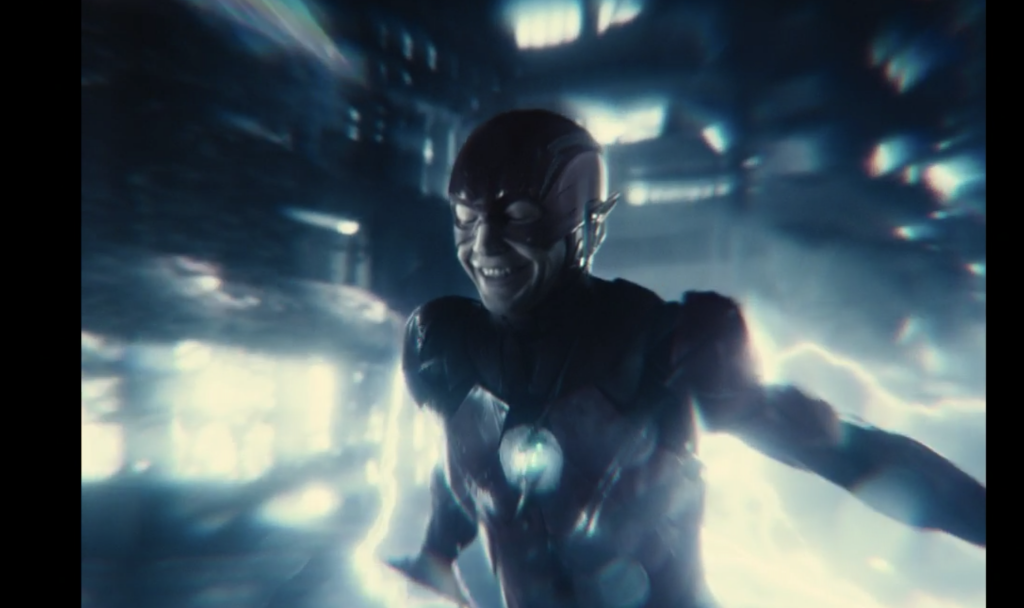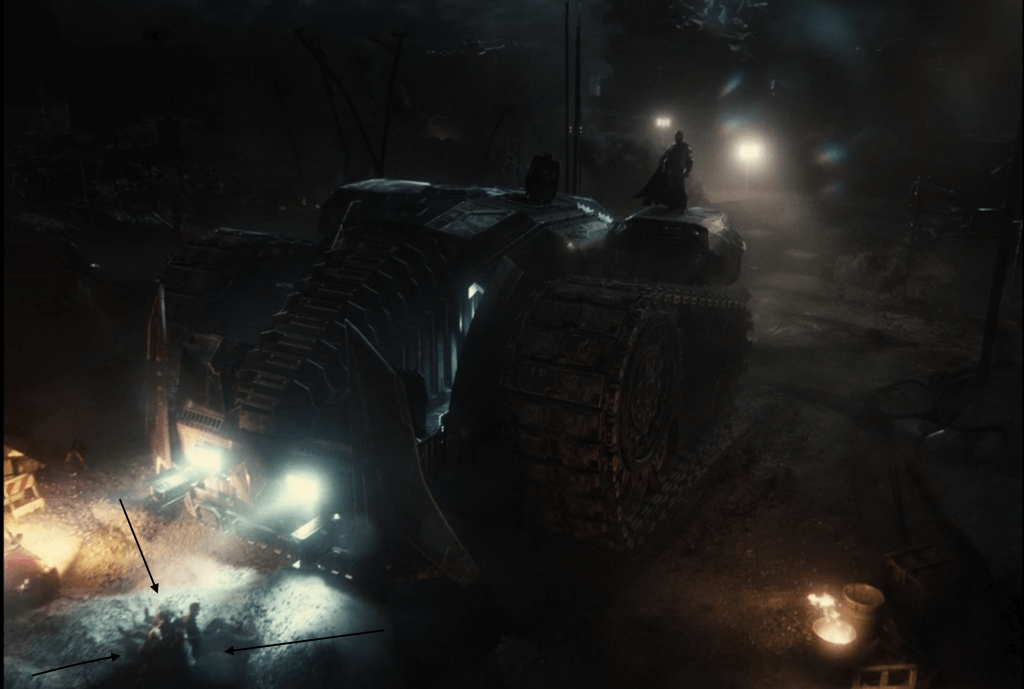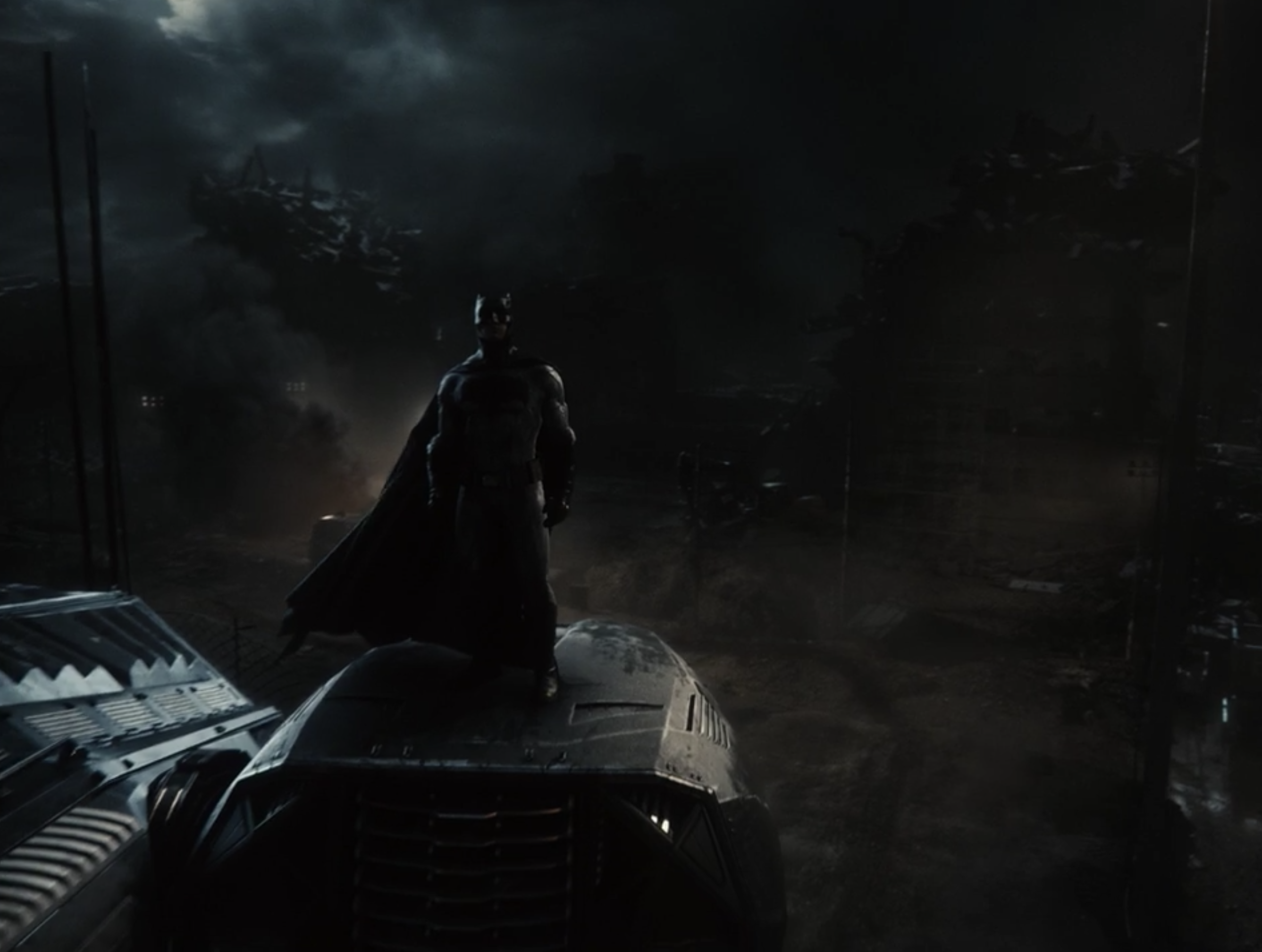The “Epilogue” section of the Snyder Cut is over 20-minutes long. It’s full of moments of closure as well as moments of foreshadowing. In order to explain how Zack Snyder’s Justice League‘s main themes emerge, let’s dig into what these ending scenes mean for each of our main character.
We kick things off with Cyborg listening to the final message from his father.
Cyborg: closure
Victor Stone’s (Ray Fisher) arc dealt with issues of self-acceptance and forgiveness. Specifically, he struggled to accept what his father, Silas (Joe Morton), had made him: a cyborg. As if that wasn’t enough, Victor also blamed his father for his mother’s death. There was a deep well of anger. But by the end of Justice League, he finally sees himself less a monster and more a hero, having gone into the world and found acceptance from others. This external acceptance has allowed for internal, self-acceptance. Which, ultimately, allows Victor to forgive his father.
Unfortunately, Silas sacrificed himself to help the Justice League. So we see Victor return to their empty apartment and confront the tape recorder his father had left for him. We hear this speech:
“Now let me speak to you from my heart. Not as a scientist. As a father—your father twice over. I brought you into the world and back to it. You can’t imagine how proud I am of who you are. Have always been. So many years with you I wasted. So many wrongs I’ve left un-righted. Everything breaks, Victor. Everything changes. The world is hurt. Broken. Unexchangeable. But the world’s not fixed in the past—only the future. The not yet. The now. The now is you. Now. Now’s your time, Victor, to rise. Do this, be this. The man I never was. The hero you are. Take your place among the brave ones. The ones that were, that are, that are yet to be. It’s time you stand…fight…discover…heal…love…win. The time is now.”
Silas Stone to Cyborg
As Victor had been someone who dwelled so heavily on the past, Silas’s speech serves as intense catharsis. It’s the permission to move on and look ahead and ditch the high school letterman’s jacket Victor still wears in his inner visions.
The speech is important, overall, as it’s applicable to Aquaman, Flash, Batman, and Wonder Woman. All of them carry baggage and damage. But after fighting together and connecting with one another, the burden seems, for each of them, a little lighter.
It also points to the larger story that waits ahead. A tragic future where Lois Lane has died, Superman has turned evil and is all Injustice-y, and the Earth is on the brink of apocalypse. While Snyder shows us glimpses of this future in the dreams of Bruce Wayne—that bleak future is not set in stone. The present is still unfolding. And “now” can make all the difference. What Silas says foreshadows the struggle our heroes will face (if Snyder gets to make additional movies) to save Lois and prevent annihilation.
But in the present, Cyborg’s story concludes with him visiting the grave of his parents. There, he sheds the trench coat he had used to hide, as much as possible, his mechanical body. It’s a declaration of confidence. Of acceptance. Finally, Victor’s self-esteem and self-respect can soar.
Next, we have Aquaman’s decision to hop into the back of a truck.
Aquaman: closure
In both Justice League versions, Aquaman/Arthur (Jason Momoa) is still at odds with his destiny. He’s a prince who runs from his birthright. Opting, instead to spend time among the humans and be the protector of a little sea-side village. In the few personal scenes Aquaman has in Justice League, most have Mera (Amber Heard) or Nuidis (Willem Dafoe) pleading Arthur to take his place amongst the Atlanteans.
So of course his final scene involves Nuidis and Mera. A brief encounter where Arthur tells them, “I gotta go see my father,” then heads off. It’s a little anti-climactic, but there’s nuance.
Like Cyborg, Arthur has struggled with the loss of his mother. Not only loss but the belief she abandoned him completely. The rage he’s felt has kept him from healthy relationships. He’s been a loner, through and through. Which is why his time with the Justice League was so important. For someone who has lived in self-exile, that camaraderie is a kind of rebirth or re-awakening.
That feeling is heightened by the awareness of Darkseid and evil forces like Darkseid. That there are only so many idle days until the next disaster. Hence Arthur’s desire to see his father. That takes us directly to the events of the 2018 Aquaman movie. There, Arthur reunites with his dad, confronts his past, and becomes the King of the Deep/Ocean Master fans hoped he would be.
We turn our attention to Ryan Choi, a character Joss Whedon had previously cut from Justice League.
Atom: foreshadow
Ryan Choi (Zheng Kai) was one of Silas’s scientists at S.T.A.R. Labs. In the Snyder Cut, he has a few moments of dialogue but nothing major. So it might be surprising to see him in the epilogue, replacing Silas as the head of the lab. There’s a shot of Choi looking at the Kryptonian spaceship, and that’s it.
You have to go outside the Snyder Cut for answers. Choi is Atom. Otherwise known as “the Ant-Man of the DC universe.” The two characters have the same general story and powers: brilliant scientists who can shrink to microscopic levels or grow to the size of Godzilla/Megazord. Ant-Man has a few more ant-related powers, while Atom has a few more molecular-related powers.
Choi’s appearance ties specifically to Silas’s statements about the “brave ones who are yet to be.” Choi is definitely one of the heroes “yet to be” and should have a pivotal role if Snyder’s universe continues.
Now to Bruce Wayne and the Hall of Justice.
Bruce Wayne: closure
“A bat man, a butler, and a wonder woman walk into a great hall” sounds like the start of a dad joke. But at the end of Snyder Cut, it’s a tease for the Hall of Justice, aka Justice League HQ.
It could seem a little weird that Bruce Wayne is surprised by how big a banquet hall is in Wayne Manor. It’s his ancestral home, after all. However, Batman v Superman showed us the mansion has been left to fall to ruin while Bruce lives off in a fancy lake house (the same lake house we see at the very end of the Snyder Cut).
Snyder explained once, “I think his father commissioned the lake house as a gift to his mother[.] A place built by her favorite architect and she loved it. When Bruce turned 18, he moved in [and] he ordered Wane Manor be left to decompose.”
Bruce would have left the mansion because it reminded him too much of his parents. Of their death and the grief he’s struggled to process. So the fact we see him return to the manor, ready to bring it back to life, is a critical step forward for a character who often keeps his emotions buried. Once again, Silas’s speech is relevant.
In fact, in the last shot of the Snyder Cut, you can see Wayne Manor is in the back right corner, under construction. The mansion will become the Justice League’s Hall of Justice. Equipped with a round table, plenty of chairs, and, I’m sure, the latest and greatest in superhero technology.
This brings us to the Flash, and why a job in a crime lab is a momentous achievement.
Flash: closure
In yet another moment dealing with parents/child dynamics, we have Barry Allen/Flash (Ezra Miller) visiting his wrongfully imprisoned father (Billy Crudup).
This is a follow-up to an earlier scene where Henry Allen is concerned that his son is too stagnant.
“You’re holding yourself back. You’re going in circles, man. Holding down three dead-end jobs. Going on four. Where do you even find the time? … You cannot keep doing this to yourself. And this is all to pay for a criminal justice degree? …
Give me your hand, man. I want you to listen to me, Barry. I want you listen to me because I mean this. I want you to give all that up [criminal justice]. And I want you to stop coming to see me. I am a drag on your life. …
Hey, you know what criminal justice would be for me? My son not wasting his life. You can be whatever you want to be—you’re brilliant, man. Absolute best of the best.
I can’t sit here and watch you run in place in Central City for some old dude who’s not going anywhere. … I want you to make your own future. You’re living in the past. Make your own future.”
Henry Allen to Barry Allen in the Snyder Cut
Note, yet again, the idea of letting go of the past and taking control of the future. Henry’s version of the Silas speech may get lost in the shuffle, as it takes place 90 minutes into a 240-minute movie. But it certainly grounds Barry in a similarly complicated state of being as the other Justice Leaguers. And gives us a means of contrast for the epilogue.
Back in the prison, Barry puts a piece of paper against the glass that separates him from his father. He explains that he got a job in a crime lab, that his foot is in the door. Henry is beyond proud, understanding that Barry has turned a corner and is no longer avoiding moving forward. Even something as small as being a tech in a crime lab is enough—as the most important step is always the first one.
It’s one of the rare scenes in Justice League and the Snyder Cut where a character gets to have a purely joyous, celebratory moment with a parent.
Barry’s final appearance has him in his Flash outfit, speeding down a city street. Despite his outrageous MPH, our human lightning bolt finds a moment to close his eyes, breathe, and smile. It’s arguably the happiest anyone is at any point in the 4-hour film.

Superman: closure
Clark Kent (Henry Cavil) is not only back from the dead, back to himself, back with Lois, but back on the farm. It’s a return to normalcy for those in the Clark’s life. And we arrive at the scene as Clark and Bruce discuss Bruce’s re-acquiring the Kent farm after the bank had foreclosed on it.
We have a single joke from Bruce about buying the bank. Then him telling Clark, “Congratulations, by the way.” Then we cut. Which can throw people off, as why are congratulations in order? Is Bruce saying congrats on being alive again? Or what?
It’s one of the “you probably missed it” moments of the Snyder Cut, but Lois Lane is pregnant. The only physical evidence happens 2-hours and 30-minutes into the movie. Lois wakes up in the middle of the night, opens her bedside drawer, and takes out her Daily Planet ID. Beneath the ID is a box for a pregnancy test.
There’s no indication whether Lois has taken the test, whether it was positive or negative, or anything like that. But if you’ve read this far, then you’re acutely aware of how parenthood is a dominant theme of the Snyder Cut (if not the dominant theme). And it combines nicely with the other major theme: the future.
So many of the heroes are dealing with issues with their parents. It makes sense, from a storytelling POV, to have one of the characters become a parent. What’s it mean to be in that position? How does that change you? How does it change your view on things? Everything Clark does as Superman will shape the world his child will inherit.
That’s what makes Lois’s potential death such a calamity in the “Knightmare” future. It’s not only Superman losing his wife but also losing his child. Hence his descent into Anti-Life Equation madness.
But, for now, in the present, everything is good. And to put the icing on the cake, we see Clark back in Metropolis, doing that classic thing where he ducks out of view, and rips his shirt open to reveal the famous S. Superman has returned.
While that would be a great place to end Justice League, it’s not in Snyder’s nature to conclude with such positivity. .
Batman: foreshadowing
It’s probably a little weird to split up Batman and Bruce Wayne, since they’re the same person. But Batman’s scenes are so different than Bruce’s.
We have a quick glimpse of the present. Batman’s in Gotham. He’s on a giant tank. Like, the most gigantic tank in the history of the world, maybe? And in the distance, Commissioner Gordon has sent the Bat Signal up into the sky. A sign that there’s new trouble afoot.

It’s a timeless moment. As Batman is in a perpetual state of responding to the Bat Signal. There’s always another crime for him to deal with. But given the subtleties of the Snyder Cut, it’s probably too reductive to think of this signal as something short term. Like, “Just Batman being Batman!” As a few minutes later, we flash to the Knightmare future where Bats leads a rag tag collection of remaining heroes and villains against evil Superman.
So this last Bat Signal isn’t just about another random crime in Gotham. Rather, it has the weight of a warning far more dire. The imagery reinforces this. The camera starts on one side of Batman, and you can see the skyline of Gotham’s buildings lit up behind them. But as it rotates to Batman’s other side, we behold ruins. Some part of Gotham that was devastated by events in BvS or Justice League or another time. What caused the ruin doesn’t matter as much as the visual itself, the transition from what a city should look like to what it shouldn’t.


With just one sweep of the camera, Snyder hints at what Batman’s world was and what it could be.
This sense of foreboding carries through into the next scene, where we find Diana back at the Shrine of the Amazons.
Wonder Woman: both?
Diana appears back in Greece, at the Shrine of the Amazons, with the Artemis arrow in-hand. The feeling here is one of longing. Diana’s been away from Themyscira, the Amazonian homeland, for decades. The reason? Unknown. In the original Wonder Woman, Diana’s mother, Hippolyta, only says once Diana goes she’ll never be able to return.
That’s why Diana ends up at the shrine. Because the arrow she holds arrived at that spot from Themyscira. That means, somehow, one day, from that spot, Diana could make her way home. It’s the only physical connection she has to the mysterious island. So she goes there to feel that bond and remember her friends and family and people.
Of all the epilogues, Diana’s has the least amount of closure. And the least amount of foreshadowing. If you’re going glass-half-full, then at least she has an idea of where Themyscira might be, a general direction that she could follow. There’s hope in that. But how much? We don’t know if she’ll ever attempt such a journey. (Though if we believe Cyborg’s vision of the future, then Diana’s body is back in Themyscira for her funeral).
This pales in comparison to the empowerment Cyborg feels. The answers Aquaman is able to pursue. The joy of Flash. The reclamation of heritage Bruce gets. And Superman’s imminent parenthood.
Wonder Woman has a lousy arrow.
But there is something. Diana and Bruce have taken on the roles of matriarch and patriarch of the Justice League. Pseudo-parents to a group of heroes who all have parental trauma. It’s an important position, because the future, quite literally, depends on it. So if you do want Diana to have a little more of a happy ending, then this is the thing to focus on. It’s not Themyscria, but, in the land of humans, she’s creating a new family. A superfamily with the power to change the future for the better.
All of this brings us to one of the main differences of the Snyder Cut Justice League—the Knightmare.
The Knightmare Future: foreshadowing
Following the individual character epilogues, the Snyder Cut‘s Knightmare Future is such a palette-cleanser. In this “knightmare,” had by Bruce Wayne, the sense of hope and potential is decimated by a destiny that seems unavoidable. Lois Lane will die. Superman will succumb to the Anti-Life Equation. And Darkseid will conquer Earth with the willing assistance of its (former) greatest hero.
How tragic.
On the most basic level, what’s fascinating about the Knightmare Future is its implications for the Justice League. Our regular line-up of heroes is vastly different. Batman, Flash (with facial hair), and Cyborg remain. But Aquaman has been replaced by Mera, his fellow-Atlantean and girlfriend/wife (depending on your source material). Wonder Woman is nowhere to be seen. And two of Batman’s usual villains have joined the team: Deathstroke and Joker.
What happened between defeating Steppenwolf to cause such a drastic personnel change? While we don’t know all the specifics, some can be gleaned from Cyborg’s interaction with Superman’s ship and the Mother Box.
When trying to revive Superman, the Kryptonian ship keeps warning Cyborg not to go through with it. Cyborg’s powers allow him to communicate with the ship’s AI in a way no one else can. It tells everyone, “This action is irreversible” then shows Cyborg glimpses of what’s to come:
- The Anti-Life Equation is revealed.
- Darkseid arrives.
- Wonder Woman has a funeral pyre in the fiery ruins of Themyscria, with the Amazons enslaved by Parademons.
- Darkseid kills Aquaman and other Atlanteans.
- Superman is surrounded by smoke and rubble, the aftermath of a powerful explosion. He kneels on the ground, distraught. In his arms, a burned corpse. Then, from the shadows, steps Darkseid. This ultimate evil puts a comforting hand on Superman’s shoulder. A moment of compassion becomes the downfall of humanity.
- Last, we see the Hall of Justice in total ruination, complete with the corpse of a Green Lantern, Wonder Woman’s broken shield, and Aquaman’s trident. Several Darkseid ships fill the sky, raining destruction. Superman, his eyes an incandescent red, floats down into the scene, landing on broken architecture. In his hand is Batman’s mask. Earth has lost the last of its heroes.
We can assume some of those details have come to pass in the Knightmare Future as dreamt by Bruce Wayne. Darkseid killed Wonder Woman and Aquaman, and Superman has gone evil thanks to the Anti-Life Equation. Meaning the Knightmare is this moment between the heroes who remain, maybe right before Superman murders all of them and brings to fruition that final scene shown to Cyborg.
All of that may seem out of left field. That it’s Zack Snyder including it because he could, because he may never get to make Justice League 2 and Justice League 3, because the what-if aspect might get Warner Brothers to greenlight Justice League 2 and Justice League 3. I’m sure all of those things are probably true.
But the Knightmare works regardless of its external implications, as it’s relevant to the central theme of Zack Snyder’s entire DC universe: parents and their children.
The reason this Knightmare future exists isn’t just because Lois Lane dies. It’s because Clark Kent loses not only his wife but also his unborn child.
It’s such a reversal of what our individual heroes had personally dealt with. Aquaman lost his mother. Cyborg lost both parents. Ryan Choi is assuming the role of his mentor. Flash lost his mother and his father has been wrongfully imprisoned ever since. Bruce Wayne lost his parents. Superman lost his parent and adopted dad. Wonder Woman is completely separated from her mother and people.
Each hero manages to work through the dark emotions spawned by their loss. Instead of succumbing to pain and grief, they uncover willpower and courage. They stand tall, undaunted, wanting to make their parents proud.
But the source of the Knightmare Future is the result of a parent losing a child. It’s the opposite of how natural order progresses. And in this universe, the implication is there’s no inspiration to be found. Only catastrophe.
It reminds me of the Snyder Cut‘s opening scene, when Superman is mortally wounded and the sound waves of his death cry pulse across the world. Loss of life is literally given physical expression in the external world. That same idea repeats with the murder of Lois and child. Except this time the result is far more grave. The spiritual extinction that Superman feels in that moment when he’s holding Lois’s skeleton manifests as the carnage Darkseid’s forces wrought. A parent’s grief reshapes the very planet.
It’s a meaningful, poignant, and thoughtful counterpoint to the sense of hope inspired in children by their parents. From Man of Steel to Batman v Superman to Justice League, Snyder has developed this theme. To invert the dynamics of that relationship and have the fate of this universe depend on it…I think that’s a beautiful and impressive choice.
Hopefully, Snyder will have the opportunity for a Justice League sequel to finish the story.
Will there be a Justice League 2?
This is currently up in the air. It would take Snyder actually wanting to do it, getting the entire cast back together, and Warner Brothers signing off on it. Even if Justice League 2 gets the green light, we’re years away from its release. 2023 or 2024.
But if you want this to be a reality, then keep using the hashtag #RestoreTheSnyderVerse on Twitter.

